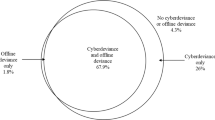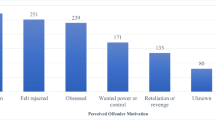Abstract
Recent developments indicate that cyber-focused crimes are on the rise among both adolescents and adults, making a proper response vital. The knowledge in regard to how to effectively respond to cyber offenders is, however, still very limited. This chapter aims to provide insight into what interventions could potentially be effective for cyber offenders, taking into account their (unique) features. In this context, we assess three types of interventions: deterrence-based, risk-based and strength-based interventions. The potential effectiveness of these interventions is assessed by integrating findings from a systematic literature study, expert interviews and offender interviews. Our findings show that various “traditional” motivational, personal and contextual factors can be found among cyber offenders (e.g. peer pressure, neutralisation), but these manifest differently online. We also found factors (e.g. intellectual motivations, social discomfort, limited awareness of illegality) that set them apart from (most) traditional offenders. In light of these (unique) features, traditional interventions such as behavioural interventions can be effective, but need to be adjusted to the online context. Deterrence-based interventions are considered effective if they are applied more swiftly and focus more on generating general deterrence. Interventions that give first offenders the opportunity to use their talents in a pro-social way could potentially be effective for preventing reoffending. Considering the wide variety of cyber offenders, a tailor-made rather than a ‘one-size-fits all’ approach seems to be the right path.
Access this chapter
Tax calculation will be finalised at checkout
Purchases are for personal use only
Similar content being viewed by others
Notes
- 1.
- 2.
In this research, we maintain a broad definition of interventions. Alternatives such as hacker competitions are also termed ‘interventions’ since they can contribute to behavioural change and a decrease of reoffending risks.
- 3.
The research was commissioned by the Dutch Ministry of Security and Justice and supervised by the WODC (Scientific Research and Documentation Centre).
- 4.
The Halt program (abbreviation of ‘Het Alternatief’ [The Alternative]) is an alternative for punishment for juveniles between 12 and 18 years of age who have been apprehended for nuisance, vandalism or petty theft, in order to avoid a criminal record.
- 5.
It is important to note that the term ‘peers’ is quite broad in the online context and that it can refer to friendships, student–mentor relations or criminal partnerships.
- 6.
In 2018 the National Cyber Security Centre of the Dutch Ministry of Justice and Security established the guideline Coordinated Vulnerability Disclosure (CVD) which aims ‘to improve the security of IT systems by sharing knowledge about vulnerabilities. Owners of IT systems can then mitigate vulnerabilities before these will be actively abused by third parties’ (NCSC, 2018).
References
Aiken, M., Davidson, J., & Amann, D. (2016). Youth pathways into cybercrime. Europol: European Cybercrime Centre/UCD Geary Institute for Public Policy/Middlesex University.
Andrews, D. A., Bonta, J., & Wormith, J. S. (2006). The recent past and near future of risk and/or need assessment. Crime & Delinquency, 52(1), 7–27.
Andrews, D. A., Zinger, I., Hoge, R. D., Bonta, J., Gendreau, P., & Cullen, F. T. (1990). Does correctional treatment work? A clinically relevant and psychologically informed meta-analysis. Criminology, 28(3), 369–404.
CBS. (2020, March 2). Less traditional crime, more cybercrime. Retrieved from https://www.cbs.nl/en-gb/news/2020/10/less-traditional-crime-more-cybercrime
Chatfield, A. T., & Reddick, C. G. (2018). Crowdsourced cybersecurity innovation: The case of the Pentagon’s vulnerability reward program. Information Polity, 23(2), 177–194.
Chen, V. H., & Chang, G. S. (2016). Active and restrictive parental mediation over time: Effects on youths’ self-regulatory competencies and impulsivity. Computers and Education, 98, 206–212.
Chiesa, R., Ducci, S., & Ciappi, S. (2009). Profiling hackers. The science of criminal profiling as applied to the world of hacking. Boca Raton, FL: Auerbach Publications.
Choo, K. R. (2011). The cyber threat landscape: challenges and future research directions. Computer & Security, 30, 719–731.
Cohen, L. E., & Felson, M. (1979). Social change and crime rate trends: A routine activity approach. American Sociological Review, 44(4), 588–608.
Cornish, D. B., & Clarke, R. V. (1986). The reasoning criminal: Rational choice perspectives on offending. New York, NY: Transaction Publishers.
Cybersprint. (2019, July 24). Invitation for hack the Hague 2019. Retrieved from https://www.cybersprint.com/news/hack-the-hague-2019
Dahan, M. (2013). Hacking for the homeland: Patriotic hackers versus hacktivists. In Article presented at the 8th international conference on information warfare and security, Denver, CO
De Bruijne, M. (2018). Hack_Right. Een interventie voor jonge, naïeve cybercriminelen. Opportuun, 24(2), 73–83.
Europol. (2016). Internet organised crime threat assessment (IOCTA) 2016. The Hague: Europol.
Farrington, D. P. (2011). Families and crime. In J. Q. Wilson & J. Petersilia (Eds.), Crime and public policy (pp. 130–157). Oxford: Oxford University Press.
Giordano, P. C., Cernkovich, S. A., & Rudolph, J. L. (2002). Gender, crime, and desistance: Toward a theory of cognitive transformation. American Journal of Science, 107(4), 990–1064.
Hampson, K. S. (2018). Desistance approaches in youth justice – The next passing fad or a sea-change for the positive? Youth Justice, 18(1), 18–33.
Hoek van Dijke, N. (2016). Onderzoeksrapportage. Jongeren over cybercrime en gedigitaliseerde criminaliteit. Den Haag: Ministerie van Justitie en Veiligheid.
Hutchings, A. (2016). Cybercrime trajectories: An integrated theory of initiation, maintenance and desistance. In T. J. Holt (Ed.), Crime online: Correlates, causes, and context (pp. 117–140). Durham: Carolina Academic Press.
Hutchings, A., & Holt, T. J. (2017). The online stolen data market: Disruption and intervention approaches. Global Crime, 18(1), 11–30.
Kleck, G., Sever, B., Li, S., & Gertz, M. (2005). The missing link in general deterrence research. Criminology, 43(3), 623–660.
Kroese, G. J., & Staring, R. H. J. M. (1993). Prestige, professie en wanhoop. Een onderzoek onder gedetineerde overvallers. Gouda Quint: Arnhem.
Laub, J. H., & Sampson, R. J. (2003). Shared beginnings, divergent lives. Delinquent boys to age 70. Cambridge: Harvard University Press.
Leukfeldt, E. R., Domenie, M. M. L., & Stol, W. (2010). Verkenning cybercrime in Nederland 2009. Den Haag: Boom Uitgevers.
Lipsey, M. W., & Cullen, F. T. (2007). The effectiveness of correctional rehabilitation: A review of systematic reviews. Annual Review of Law and Social Science, 3, 297–320.
Lowenkamp, C. T., Latessa, E. J., & Holsinger, A. M. (2006). The risk principle in action: What have we learned from 13,676 offenders and correctional programs? Crime & Delinquency, 52(1), 77–93.
McMurran, M., & Ward, T. (2010). Treatment readiness, treatment engagement and behaviour change. Criminal Behaviour and Mental Health, 20(2), 75–85.
McNeill, F., Farrall, S., Lightowler, C., & Maruna, S. (2012). Reexamining evidence-based practice in community corrections: Beyond ‘a confined view’ of what works. Justice Research and Policy, 14(1), 35–60.
National Crime Agency. (2017). Pathways into cyber crime. Retrieved from https://www.nationalcrimeagency.gov.uk/who-we-are/publications/6-pathways-into-cyber-crime-1/file/
NCSC. (2018). Coordinated vulnerability disclosure: The guideline. The Hague: NCSC.
Odinot, G., Verhoeven, M. A., Pool, R. L. D., & de Poot, D. J. (2017). Organised cybercrime in the Netherlands: Empirical findings and implications for law enforcement. The Hague: WODC.
Oosterwijk, K., & Fischer, T. F. C. (2017). Interventies jeugdige daders cybercrime. Den Haag: WODC.
Paternoster, R. (2010). How much do we really know about criminal deterrence. Journal of Criminal Law and Criminology, 100(3), 765–824.
Paternoster, R., McGloin, J. M., Nguyen, H., & Thomas, K. J. (2012). The causal impact of exposure to deviant peers: An experimental investigation. Journal of Research in Crime and Delinquency, 50(4), 476–503.
Politie. (2020, April 21). Gamechangers: houd jongeren weg bij cybercrime. Retrieved from https://www.politie.nl/nieuws/2020/april/21/gamechangers-campagne.html
Power, A., & Kirwan, G. (2014). The future of cyberpscyhology. In A. Power & G. Kirwan (Eds.), Cyberpsychology and new media: A thematic reading (pp. 231–236). London: Psychology Press.
Rogers, M. K. (2010). The psyche of cybercriminals: A psycho-social perspective. In S. Ghosh & E. Turrini (Eds.), Cybercrimes: A multidisciplinary analysis (pp. 217–235). Heidelberg: Springer.
Rogers, M. K., Smoak, N. D., & Liu, J. (2006). Self-reported deviant computer behavior: A Big-5, moral choice, and manipulative exploitive behavior analysis. Deviant Behavior, 27(3), 245–268.
Sasson, H., & Mesch, G. (2014). Parental mediation, peer norms and risky online behaviour among adolescents. Computers in Human Behaviour, 33, 32–38.
Seigfried-Spellar, K. C., O’Quinn, C. L., & Treadway, K. N. (2015). Assessing the relationship between autistic traits and cyberdeviancy in a sample of college students. Behaviour & Information Technology, 34(5), 533–542.
Smith, R., Grabosky, P., & Urbas, G. (2004). Cyber criminals on trial. Port Melbourne, VIC: Cambridge University Press.
Steinmetz, K. F. (2015). Craft(y)ness. An ethnographic study of hacking. The British Journal of Criminology, 55(1), 125–145.
Suler, H. (2004). The online disinhibition effect. Cyberpsychology & Behavior, 7(3), 321–236.
Švábenský, V., Vykopal, J., Cermak, M., & Laštovička, M. (2018). Enhancing cybersecurity skills by creating serious games. In Proceedings of 23rd Annual ACM Conference on Innovation and Technology in Computer Science Education (ITiCSE’18). New York, NY: ACM.
Sykes, G. M., & Matza, D. (1957). Techniques of neutralization: A theory of delinquency. American Sociological Review, 22(6), 664–670.
Tanczer, L. M. (2017). The terrorist – Hacker/Hacktivist distinction: An investigation of self-identified hackers and Hacktivists. In M. Conway, L. Jarvis, O. Lehane, S. Macdonald, & L. Nouri (Eds.), Terrorists’ use of the internet (pp. 77–92). Amsterdam: IOS Press.
Turgeman-Goldschmidt, O. (2005). Hacker’s accounts: Hacking as a social entertainment. Social Science Computer Review, 23(1), 8–23.
Van der Wagen, W. (2018). The Cyborgian deviant: An assessment of the hacker through actor network theory. Journal of Qualitative Criminal Justice & Criminology, 6(2), 157–178.
Van der Wagen, W., Althoff, M., & Van Swaaningen, R. (2016). De andere ‘anderen’. Een exploratieve studie naar processen van labelling van, door en tussen hackers. Tijdschrift over Cultuur & Criminaliteit, 6(1), 27–41.
Van der Wagen, W., Van’ t Zand, E., Matthijsse, S., & Fischer, T. F. C. (2020). Cyberdaders: Uniek profiel, unieke aanpak? Een onderzoek naar kenmerken van en passende interventies voor daders van cybercriminaliteit in enge zin. Den Haag: Wetenschappelijk Onderzoek-en Documentatiecentrum.
Vermaas, P. (2018). Actiedag DDoS-aanvallen. Opportuun, 2.
Ward, M. (2017). Rehab camp aims to put young cyber-crooks on right track. BBC. Retrieved From https://www.bbc.com/news/technology-40629887
Weulen Kranenbarg, M. (2018). Cyber-offenders versus traditional offenders: an empirical comparison. Dissertation. Retrieved from http://dare.ubvu.vu.nl/handle/1871/55530?show=full
Wible, B. (2003). A site where hackers are welcome: Using hack-in contests to shape preferences and deter computer crime. The Yale Law Journal, 112(6), 1577–1623.
Xu, Z., Hu, Q., & Zhang, C. (2013). Why computer talents become computer hackers. Communications of the ACM, 56(4), 64–74.
Zebel, S., De Vries, P., Giebels, E., Kuttschreuter, M., & Stol, W. (2013). Jeugdige daders van cybercrime in Nederland: Een empirische verkenning. Den Haag: WODC.
Author information
Authors and Affiliations
Corresponding author
Editor information
Editors and Affiliations
Rights and permissions
Copyright information
© 2021 The Author(s), under exclusive license to Springer Nature Switzerland AG
About this chapter
Cite this chapter
van der Wagen, W., Fischer, T., Matthijsse, S., van ’t Zand, E. (2021). Unique Offender, Unique Response? Assessing the Suitability and Effectiveness of Interventions for Cyber Offenders. In: Weulen Kranenbarg, M., Leukfeldt, R. (eds) Cybercrime in Context. Crime and Justice in Digital Society, vol I. Springer, Cham. https://doi.org/10.1007/978-3-030-60527-8_20
Download citation
DOI: https://doi.org/10.1007/978-3-030-60527-8_20
Published:
Publisher Name: Springer, Cham
Print ISBN: 978-3-030-60526-1
Online ISBN: 978-3-030-60527-8
eBook Packages: Law and CriminologyLaw and Criminology (R0)




